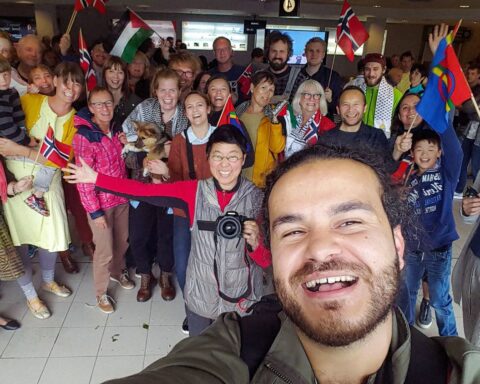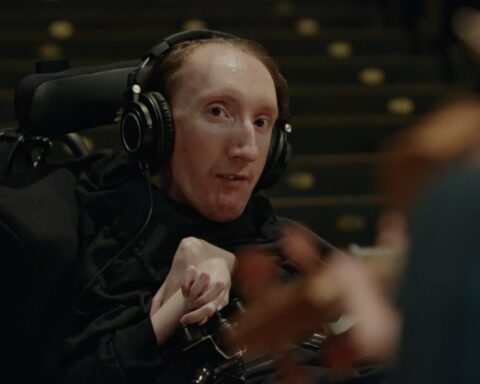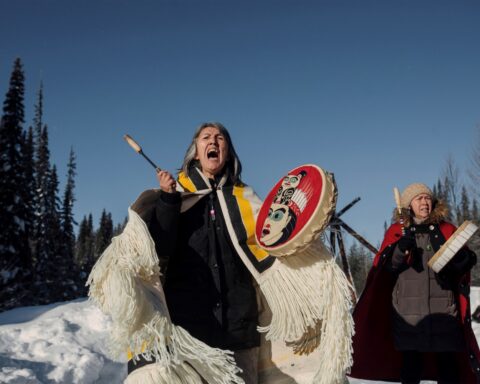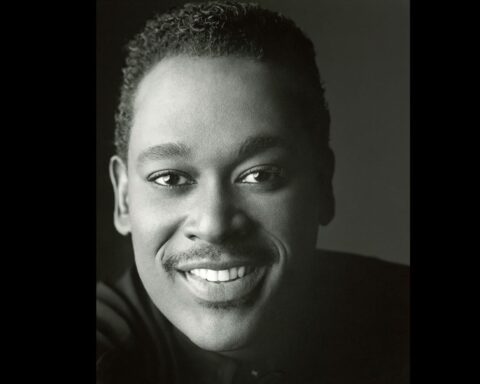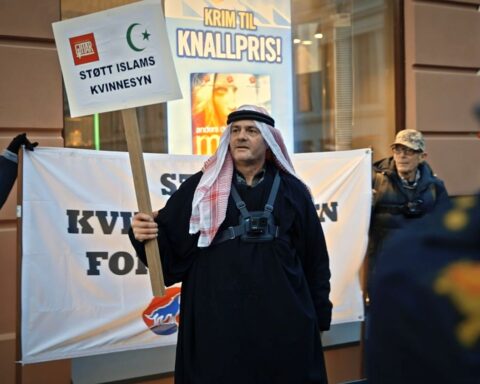Living with Giants brought to the Canadian Spectrum at Hot Docs one of several essential stories about Canada’s northern communities. The directorial duo of Sébastien Rist and Aude Leroux-Lévesque, who won the festival’s emerging Canadian filmmaker award, invite the audience into the world of Paulusie, a young Inuk man who encounters a moral struggle following a violent encounter that erupts after a school party. The doc poetically shows complex social issues, such as violence, depression, and suicide, within the community of Inukjuak (the Inuktitut word for “giant”). The film shows Paul’s hopes as well as the demons with which he wrestles as he provides for his adoptive parents and shares his life with his girlfriend, Nikuusi.
POV sat down with Living with Giants subject Kikuusi and directors Sebastien Rist and Aude Leroux-Lévesque, accompanied by their then-nine-day-old son Laurier, during the festival to discuss the film and its potential to spark dialogue among Canadian youth.
POV: Pat Mullen
SR: Sébastien Rist
AL: Aude Leroux-Lévesque
NE: Nikuusi Elijassiapik
POV: You previously worked with Paulusie on another film and you said that he was eager to work on this one, but was the community receptive to you filming their story?
SR: Well, when we started working on this project, we thought, ‘Where will we stay?’ Paul replied, ‘You can stay with me!’ Once we got to know the families [up north], they accepted us. Communities are big families where everyone is related or at least knows each other, so once we got our ‘in,’ so to speak, we were in.
PM: And Nikuusi, how did you feel about sharing this story?
NE: It was amazing.
PM: How so?
SR: We met Nikuusi a year after. We started filming Paul in 2013, and then when we spent a whole summer in Inukjuak, I remember getting off the plane and Paul being like, ‘Here’s my girlfriend Nikuusi I was talking about!’ And there you were, and we literally started filming about two hours later—
NE: Yeah, that’s right.
SR: So the scene at the beginning of the film when they’re in the bed, I was like, ‘Ok, Nik, we’re going to start filming. You’re ok?’ and we just started filming, and everything was cool like that.
POV: I really like the way the film is structured in four acts with the first part offering a sort of ‘dreamy sequence,’ and then the period after Paul’s arrest, then the hunting trip, and then the final chapter. How did you decide to approach the story that way?
AL: We didn’t know if it was going to be chronological or not until after all the events happened. We knew we wanted to focus on Paul’s dreams. We juggled with the idea of mixing everything up in terms of the chronology, but we decided to stick with it and make it the experience as we lived it with him. We really wanted to take the time to establish the environment, and then we had to follow with some actions and events.
SR: There was a big debate about how much information to reveal beforehand, or how much to keep as a surprise. We realised we might as well have the audience live the same experience that we lived, become friends with him, are introduced to his world, realise that he’s a complex guy, and then something happens, and it’s a shock. And it was—utter shock—and it was awful and we grieved just like everybody as we went through it.
POV: The twist really comes as a surprise. Did that motivate you to emphasise life in the film?
AL: Absolutely. We obviously started filming not knowing what would happen. What we had in mind the whole way through was to make a positive film about this amazing young man that we knew, who was very charismatic and open minded and imaginative. So, in the end, we decided to honour his life.
POV: And how hard was it to continue? Were there any talks of stopping the film?
SR: Yeah. When he was arrested, that was one step. We were like, ‘What do we do, do we take a break?’ And at that moment, people were saying, ‘Listen, you’re coming face to face with some major issues up north, so work with your project and go through it.’ We were up north when that happened, and the community kept us going. And after everything unfolded, Nik, you were the one who told us to come back and finish the interviews.
POV: Really? What motivated you to keep going?
NE: We lose our loved ones and we have to go through it, no matter what.
POV: I like at the end when you’re at the residence. What did you learn from that experience?
NE: It was mostly for college, pre-college.
AL: Did it help you go through what happened?
NE: It did help me because I had curfew, but I still had drinking problems.
POV: How do you think the film will help teens in your community? Can it change anything?
NE: Yeah, it helps people talk to each other.
POV: Yes, it really invites a conversation.
SR: I think it definitely does for the people around him—Paul’s family and friends. We showed the film to them before bringing it here. We felt we had to show it up north, so we took it back to the family. I think a lot of people took it as a healing process. They laughed at certain scenes, but they also cried and cried and cried. Everyone said ‘Thank you,’ after the movie. And Allie, Paul’s best friend and cousin who you see in the movie, I’ll always remember how he said to us, ‘You know, after seeing the movie, I slept well for the first time in a year.’
POV: That’s nice.
SR: It’s little comments like that from the community that show that the movie is doing the right thing by the family.
POV: It does feel very cathartic. And now, what responsibilities does a filmmaker have not only in telling a story such as this one, but also in now sharing it?
AL: It’s a big responsibility. The first thing was to go back to the family and Nikuusi and show them the film first, so that’s been done, and as [Sébastien] said, they liked it. We’d also like to go to all Inuit communities in Nunavik in Northern Quebec. If we can go all over Canada, that would be even better. We’re trying to develop a programme with partners so that over the coming year, we’d go to every village and show the film.
SR: There are a few things lined up, but nothing’s confirmed. The logistics for an effort like this are huge.
POV: It is a lot of travelling.
AL: But I think we should take the opportunity with what’s in the media right now with the suicide crisis [in Attawapiskat] to bring some partners on board not only to show the film, but also to help spark discussion.
SR: We didn’t want to make a story that would be a lecture—there’re no stats, no text, no historical context. We just wanted people to watch this as a film and absorb it. If we can get people talking, in a different way, then the film does its job.
POV: And have you watched the film since having you son?
AL: No… [Laughs]
POV: I assume it will be fairly different?
SR: Yeah… it might be! That’s a good question.
AL: That’s funny. We’ll find out tonight when we watch it tonight on the big screen.
SR: He’s nine days old, so we’re both very emotional. I’m just on a high. Seeing on the big screen with people we know? There won’t be any dry eyes for sure.
POV: No, I bet not. [Laughs] Now, to get a bit more serious, when you were looking back at the film through the editing, were there things you noticed about Paul after the fact either through reviewing the footage or through the editing?
AL: We knew that Inuit legends and his dreams were important to his life and to his personality. But we were surprised when our editors discovered that things actually happened during the filming that were an application of those legends and dreams. It was pretty crazy to find these moments that tie the themes together and push the poetry forward.
SR: Just like the whole fox metaphor. [The film features a recurring analogy of a fox, both in Paul’s interviews and in candid images in the film.] Our editor found that.
POV: That shot of the fox at the end is amazing.
SR: We didn’t realise that it was there that day because it was minus forty and we were burning things and in the zone filming. The last thing we saw with Paul was the fox. And the fox that we see at the beginning was literally the first thing we filmed with him. When got off the plane in 2013 and he was like, ‘Let’s go in the tundra and hunt,’ and that’s the first thing we saw. There are many animals in the tundra and we’ve been back many times, but we don’t always see them. It was really weird to realise that coincidence happened.
AL: And we discovered his journals afterwards—we didn’t know they existed—and with the family’s consent we used them in the film. We discovered in the editing process that his remorse was bigger than he thought.
SR: He definitely felt guilty. He’d express his feelings about being in prison and having to deal with it. He’d often express his feelings in a different creative way. But later, those letters were concrete evidence. He wrote a message on the wall—
POV: That image is very powerful.
SR: Yeah, so everything pieces together and you realise that with any situation like this, you wonder why you didn’t see things and if you could have helped. We were there, we were open with him and we felt we did everything we could.
POV: How do you hope people will respond tonight?
NE: I hope people love it. Maybe they will want to go to Inukjuak or somewhere in Nunavik.
AL: We hope they discover an Inuit community that’s much different from what they think about the north. We think we know a lot about the north, but we don’t.
POV: That’s true.
AL: We hope people discover a great family and a great community, and ultimately see that there are so many different aspects to the north.
SR: As much as it’s radically different up there, many of the friendships and family relationships are universal. And, like Nikuusi said, if people are more willing to go there and talk, that’s the start of a better dialogue.
POV: It really invited a discussion.
SR: We realise that the film is heavy. It’s not a burlesque show [laughs] or something that’s mainstream, but hopefully it gets people talking. And, as we said, we’re planning a screening process up north that’s going to develop over the next year and a half, but that’s a promise. Every family up north knows someone in the community who’s been touched by a story like this one and we definitely want to get people talking.
NE: It was crazy. I was crying like crazy during the first interview in his room when we started again.
AL: It’s true. We never interviewed Nikussi until later on. She was a secondary character, but she becomes the main one by the end. That was a rough one.
POV [to Nikuusi]: Was there anything that you watched in the film that really made you happy with Paul?
NE: Knowing that he loved me.
Hot Docs runs April 28 – May 8. Visit www.hotdocs.ca for more information.




